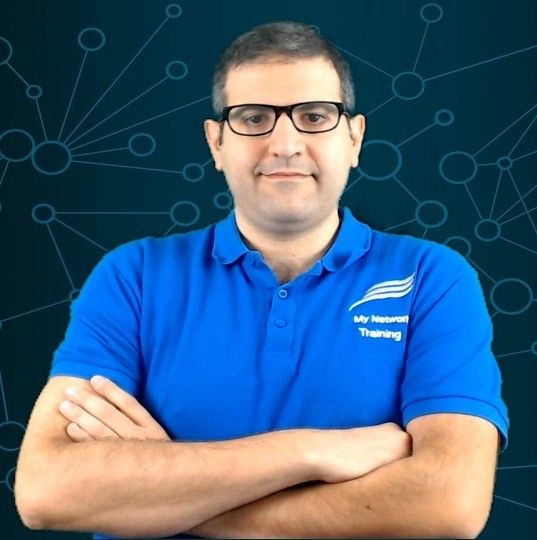
MikroTik Routing Engineer with LABS
Understand the topics of the MikroTik MTCRE track and be ready for the MTCRE exam
***This course is not officially sponsored by MikroTik and not an authorized course by MikroTik. We are neither affiliated with nor endorsed by MikroTik. We respect the Trademarks of the mentioned company and institution.***
What you'll learn
- Understand Static and default Routes
- Understand the more specific routes on static routes
- Understand and configure ECMP
- Understand route distance
- Understand the difference between FIB and RIB tables
- Understand and configure Routing mark and route policy
- Understand and configure Recursive routes with scope/target-scope usage
- Understand what VPN is and the different types of VPN
- Understand and configure the follow tunnels: IPIP, EoIP, PPTP, SSTP, L2TP, PPPoE
- Understand what is VLAN and how to use it
- Configuring VLAN
- Understand and configure Q-in-Q
- Understand what is Link-state Routing Protocol
- Understand what is OSPF Routing Protocol
- Understand how OSPF use SPF algorithm for calculating the best route
- Understand how OSPF works
- Understand OSPF hello packets and LSA's types
- Understand the OSPF network structure such as Areas and Router Types
- Understand the need of DR/BDR election and configure them in OSPF
- Understand and configure External router distribution (Type1, Type2)
- Understand and configure load balancing on OSPF
- Understand and configure Router aggregation on OSPF
- Understand and configure stub areas (Stub, Totally Stub, NSSA, Totally NSSA)
- Understand and configure Virtual links in OSPF
Requirements
- Having MikroTik MTCNA knowledge
MikroTik MTCRE is at the 2nd level certificate from MikroTik, and it is considered in the Engineering level. This course will speak about everything related to Routing at the Intermediate level. Being MikroTik MTCRE certified is a prerequisite for the higher level Routing certificate which is MTCINE
For this reason, I have designed this course to help you understanding how Routing happens in MikroTik and be read for the MikroTik MTCRE exam.
This course will contain theories but a lot of LABS. For this reason, if you want to follow this course I advice you to have 1 PC and 5 or MikroTik Routers with UTP Cables. Alternatively, you can use MikroTik CHR on GNS3 to emulate the LABS, and which GNS3 you don't require any physical Routerboards as all LABS can be done on GNS3
In this course, you will learn the following topics:
- More specific routes
- ECMP
- How to force gateway over specific interface
- Gateway reachability check and route distance
- Routing mark and route policy
- Recursive next-hop and scope/target-scope usage
- What is OSPF?
- How OSPF protocol works
- Hello protocol
- Database distribution and LSA types explained
- OSPF network structure
- Areas
- Router types
- OSPF neighbors and neighbor states (DR and BDR election)
- External Route Distribution methods (type1, type2)
- Interface cost and interface types (broadcast, NBMA, etc.)
- SPT calculation algorithm
- OSPF and multicast (problems with NBMA)
- Stub, NSSA and area ranges (route aggregation)
- Virtual links, usage and limitations
- SPF routing filters and limitations
- What is VPN?
- Different types of VPN
- Site to site connectivity with tunnels
- IPIP, EoIP, PPTP, SSTP, L2TP, PPPoE
- VLAN and it's usage
- VLAN and managed switch
- VLAN and switch chip configuration on RouterBOARDs
- Q-in-Q implementation
As you can see, there are many topics that are covered in this course and on each of the topics there are sub-topics. A lot of LABS will be done on each of the topics so you can understand practically how you can configure all these topics on the MikroTik.
Finally, if you want to have a global understanding of all MTCRE topics and be ready for the MTCRE exam, all you need to do is to register to my course and I assure that your goal will be achieved.
- Students who want to learn and be ready for the MikroTik MTCRE exam
- Engineers who want to have more knowledge on Routing in MikroTik
Your Instructor

Hello everyone. My name is Maher Haddad and I am a Certified MikroTik Trainer, Cisco Authorized Instructor and LigoWave Authorized Trainer.
I have decided to make this online school to share my knowledge to the community. All my courses are based on theory and hands-on LABS so you can practise while learning.
More than 100K happy students have joined mynetworktraining.com up to year 2022.
I hope you will enjoy watching my courses.
Course Curriculum
-
PreviewMikroTik Routing Overview and LAB (24:45)
-
StartMore specific static routes (24:33)
-
StartEqual Cost Multi-Path (ECMP) (13:47)
-
StartStatic Route - Check Gateway (Ping - ARP) (14:22)
-
PreviewChanging TTL on MikroTik Routers (12:37)
-
StartRecursive Routes (Scope - Target Scope) (17:13)
-
StartMark Routing and Policy Based Routing (18:13)
-
PreviewIntroduction to VPN (0:57)
-
StartWhat is VPN and why is it important to use it in our network (15:52)
-
StartPPTP Tunneling Protocol - Explanation (8:30)
-
StartConfiguring PPTP site to site VPN (20:49)
-
StartConfiguring PPTP Client to site VPN (same local IP addresses) (23:54)
-
StartConfiguring PPTP with Bridge Control Protocol (BCP) (23:17)
-
StartL2TP IPSEC Tunneling protocol - Explanation (7:10)
-
StartConfiguring L2TP site to site VPN (23:02)
-
StartConfiguring L2TP IPSEC client to site VPN (10:38)
-
StartSSTP Tunneling Protocol - Explanation (8:08)
-
StartConfiguring SSTP site to site VPN (without certificates) (14:10)
-
StartConfiguring SSTP site to site VPN (with Certificates) (20:31)
-
StartConfiguring SSTP client to site VPN (16:11)
-
Start41- Understand and Configure PPPoE Server and Client on MikroTik (18:43)
-
StartIntroduction to IPIP Tunnel (0:49)
-
StartConfiguring IPIP Tunneling Protocol on MikroTik (22:06)
-
StartIntroduction to EOIP Tunnel (0:55)
-
PreviewConfiguring EOIP Tunneling Protocol on MikroTik (18:59)
-
StartConfiguring EOIP Tunnel over L2TP Tunnel (13:24)
-
StartWhy we need VLAN's in our network and how VLAN's work - Part 1 (17:30)
-
StartWhy we need VLAN's in our network and how VLAN's work - Part 2 (15:57)
-
StartLesson 5 - LAB #5 - Configuring VLAN's with DHCP - Part 1 (17:17)
-
StartLesson 5 - LAB #5 - Configuring VLAN's with DHCP - Part 2 (12:28)
-
Start61- VLAN's using the Switch Chip (19:01)
-
Start62- VLAN's without using the Switch Chip (10:40)
-
StartQ-in-Q implementation (17:04)
